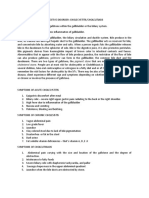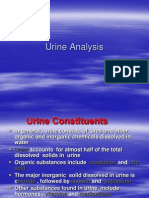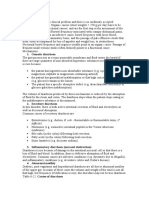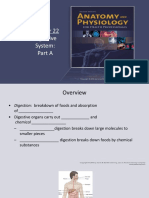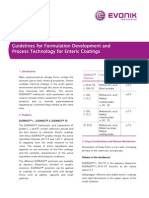0 ratings0% found this document useful (0 votes)
51 viewsDigestive Tract
Digestive Tract
Uploaded by
LILY MAINThe document summarizes the process and purpose of a stool examination. A stool sample is collected without contamination and sent to a laboratory for gross, microscopic, and chemical examination to help diagnose conditions of the digestive tract like infection, malabsorption, and bleeding. The examination looks at attributes of the stool like consistency, color, odor, and presence of mucus, blood, fat, or bacteria/parasites. Abnormal findings can indicate issues like inflammation, bleeding, or malabsorption.
Copyright:
© All Rights Reserved
Available Formats
Download as DOCX, PDF, TXT or read online from Scribd
Digestive Tract
Digestive Tract
Uploaded by
LILY MAIN0 ratings0% found this document useful (0 votes)
51 views2 pagesThe document summarizes the process and purpose of a stool examination. A stool sample is collected without contamination and sent to a laboratory for gross, microscopic, and chemical examination to help diagnose conditions of the digestive tract like infection, malabsorption, and bleeding. The examination looks at attributes of the stool like consistency, color, odor, and presence of mucus, blood, fat, or bacteria/parasites. Abnormal findings can indicate issues like inflammation, bleeding, or malabsorption.
Original Title
2
Copyright
© © All Rights Reserved
Available Formats
DOCX, PDF, TXT or read online from Scribd
Share this document
Did you find this document useful?
Is this content inappropriate?
The document summarizes the process and purpose of a stool examination. A stool sample is collected without contamination and sent to a laboratory for gross, microscopic, and chemical examination to help diagnose conditions of the digestive tract like infection, malabsorption, and bleeding. The examination looks at attributes of the stool like consistency, color, odor, and presence of mucus, blood, fat, or bacteria/parasites. Abnormal findings can indicate issues like inflammation, bleeding, or malabsorption.
Copyright:
© All Rights Reserved
Available Formats
Download as DOCX, PDF, TXT or read online from Scribd
Download as docx, pdf, or txt
0 ratings0% found this document useful (0 votes)
51 views2 pagesDigestive Tract
Digestive Tract
Uploaded by
LILY MAINThe document summarizes the process and purpose of a stool examination. A stool sample is collected without contamination and sent to a laboratory for gross, microscopic, and chemical examination to help diagnose conditions of the digestive tract like infection, malabsorption, and bleeding. The examination looks at attributes of the stool like consistency, color, odor, and presence of mucus, blood, fat, or bacteria/parasites. Abnormal findings can indicate issues like inflammation, bleeding, or malabsorption.
Copyright:
© All Rights Reserved
Available Formats
Download as DOCX, PDF, TXT or read online from Scribd
Download as docx, pdf, or txt
You are on page 1of 2
Stool examination is a series of tests done on a stool sample to help diagnose certain conditions
affecting the digestive tract. This includes infection, malabsorption, and gastrointestinal
bleeding.
Before the test, the patient should avoid medicines that might alter the results. This includes
antacids, antidiarrhea and antibiotic medication. If the stool is being tested for blood, certain
foods might also be avoided such as red meats and carrots.
For the collection, the patient is asked to collect the stool in a clean, wide mouth container. The
stool should be uncontaminated with urine or any other body secretions that might affect the
result of the test. More than 2 grams of stool is required for the stool examination and the
container should be labeled with the name of the patient and the date it was collected.
The stool is then sent to the laboratory for examination.
The stool examination is divided into three parts which is the gross examination, microscopic
examination and chemical examination.
In gross examination, you have to check for the consistency of the stool, such as if it is loosely
formed stools, watery stools as seen in diarrhea, dry or hard stools as seen in constipations, pasty
stool that are due to high fat content and ribbon like stool as seen in rectal narrowing and partial
obstruction.
The color of stools are brown which is normal and is due to stercobilinogen, yellow or yellow
green which is seen in diarrhea, black and tarry stools which may indicate bleeding from upper
GI tract, reddish color which may indicate bleeding in lower GI tract, clay colored stools that
might indicate biliary obstruction and pale color stool that might indicate malabsorption.
You also have to check for the quantity of the stool, the normal quantity of stool is 100 to 200
grams per day. Disorders with poor food breakdown and absorption might lead to large bulky
frothy and foul smelling stools.
Next is the odour, the normal odor of the stool is due to indole and skatole which are formed by
bacterial fermentation and putrefaction. The foul odor is due to undigested protein and excessive
intake of carbohydrates and sickly odor is due to undigested lactose and fatty acids.
Lastly is the mucous, it is a translucent gelatinous material in the surface of the stool. It can be
seen in severe constipation and mucous colitis. While mucus and blood are seen in patients with
ulcerative colitis, amoebiasis and etc.
Next is microscopic examination, it is done to detect the presence of leukocytes, RBC,
macrophages, fats, ova, cyst and other microorganisms.
Normal stools may contain occasional white blood cells. To look for WBC, the smears must be
prepared from the area of mucus or from watery stools. Increase number of WBC is associated
with shigellosis, clostridium difficile, salmonella and campylobacter infection.
RBC in stool might indicate bleeding in upper or lower GI as evidence by either bright red
bleeding or black tarry stool.
Presence of macrophages in the stool is indicative of dysentery and ulcerative colitis.
Presence of fat in the stool might be cause by malabsorption, deficiency of pancreatic digestive
enzyme or deficiency of bile.
Stool pH depends on the dietary intake and bacterial fermentation in the small intestine. Alkaline
stool might be seen in patients with colitis, diarrhea and antibiotic therapy while acidic stool is
seen on disaccharide deficiency, fat and carbohydrate malabsorption. The reducing substance in
the stool is important in infants with chronic diarrhea to rule out lactose intolerance.12
You might also like
- ULTRASOUND Abdomen Normal MeasurementsDocument20 pagesULTRASOUND Abdomen Normal Measurementsadinatop100% (6)
- 300 Signs and Symptoms of Celiac DiseaseDocument7 pages300 Signs and Symptoms of Celiac DiseaseIon Logofătu AlbertNo ratings yet
- Med Geeks Clinical Lab GuideDocument17 pagesMed Geeks Clinical Lab GuideHuy Hoang100% (1)
- Stool ExaminationDocument82 pagesStool Examinationambadepravin100% (2)
- Acid Peptic DisordersDocument72 pagesAcid Peptic DisordersAteeq ur RehmanNo ratings yet
- NCLEX Practice Questions - Digestive SystemDocument27 pagesNCLEX Practice Questions - Digestive SystemGeevee Naganag Ventula100% (1)
- A Study Course in Nutrition by DR Forrest ShakleeDocument89 pagesA Study Course in Nutrition by DR Forrest ShakleeEmpresario100% (1)
- Stool ExaminationDocument53 pagesStool ExaminationAmirAmeer AliNo ratings yet
- A must study FundamentalDocument37 pagesA must study Fundamentalmakoniwishes47No ratings yet
- Routine UrinalysisDocument4 pagesRoutine UrinalysisDanica Joy Christelle L. PilarNo ratings yet
- Stool Exam and Lab HepatitisDocument10 pagesStool Exam and Lab HepatitisGabriella TjondroNo ratings yet
- Description:: Fecalysis (Stool Examination)Document3 pagesDescription:: Fecalysis (Stool Examination)Xian AlbsNo ratings yet
- Stool AnalysisDocument8 pagesStool AnalysisAbed AbusalemNo ratings yet
- MethodsDocument3 pagesMethodstinejoytulaganNo ratings yet
- Stool Color, Changes in Color, Texture, and FormDocument5 pagesStool Color, Changes in Color, Texture, and FormlrmonarNo ratings yet
- UrineDocument17 pagesUrinealynne_pascua8530No ratings yet
- Urine AND Feces: Prepared By: Group 5Document37 pagesUrine AND Feces: Prepared By: Group 5Chantal RaymondsNo ratings yet
- Understanding StoolDocument6 pagesUnderstanding StoolJonni Arianto RangkutyNo ratings yet
- Cholesterol Stone. People Are at Most Risk For Cholecystitis or Cholelithiasis Is Obese Women Who HaveDocument4 pagesCholesterol Stone. People Are at Most Risk For Cholecystitis or Cholelithiasis Is Obese Women Who HavePatriot DolorNo ratings yet
- UrinalysisDocument6 pagesUrinalysisAsmadayana HasimNo ratings yet
- FECALYSISDocument43 pagesFECALYSISKen LaguiabNo ratings yet
- Clinical Lab Guide: by MedgeeksDocument17 pagesClinical Lab Guide: by MedgeeksHuy HoangNo ratings yet
- Human Feces: Human Feces (Or Faeces in British English Latin: Fæx) Are The Solid or SemisolidDocument10 pagesHuman Feces: Human Feces (Or Faeces in British English Latin: Fæx) Are The Solid or SemisolidJ.B. BuiNo ratings yet
- Human Feces: Human Feces (Or Faeces in British English Latin: Fæx) Are The Solid or SemisolidDocument10 pagesHuman Feces: Human Feces (Or Faeces in British English Latin: Fæx) Are The Solid or SemisolidJ.B. BuiNo ratings yet
- Ikp 4-MavzuDocument13 pagesIkp 4-Mavzubegzodrahmonberdiyev03No ratings yet
- FesesDocument27 pagesFesesNurul Aeni FitriyahNo ratings yet
- Stool AnalysisDocument8 pagesStool AnalysisLuciaGomez100% (1)
- Stool Analysis: What Is The Stool or Feces?Document28 pagesStool Analysis: What Is The Stool or Feces?Annisa SafiraNo ratings yet
- 2 3 4 General Stool Examination Intestinal Pathogenic Protozoa 2Document24 pages2 3 4 General Stool Examination Intestinal Pathogenic Protozoa 2بلسم محمود شاكرNo ratings yet
- Urine and Feces ExaminationsDocument36 pagesUrine and Feces Examinationsshubhamthakurst1108No ratings yet
- Abnormal UrineDocument9 pagesAbnormal Urineshahramfatah5No ratings yet
- Characteristics: DurationDocument7 pagesCharacteristics: Durationkbarn389No ratings yet
- Human Feces - WikipediaDocument62 pagesHuman Feces - Wikipediabdaniel79No ratings yet
- Urinalysis: Clin. Immunol. / Lab. Work/ Renal Disorders/ Urine Analysis/ Dr. Batool Al-HaidaryDocument11 pagesUrinalysis: Clin. Immunol. / Lab. Work/ Renal Disorders/ Urine Analysis/ Dr. Batool Al-HaidaryIM CTNo ratings yet
- Case StudyDocument21 pagesCase StudyFaye ingrid RasqueroNo ratings yet
- Clinical Pathology Fecalysis and UrnalysisDocument16 pagesClinical Pathology Fecalysis and UrnalysisRem Alfelor100% (3)
- Urinalysis Lab StudentDocument13 pagesUrinalysis Lab Studentnicv120% (2)
- StoolDocument4 pagesStoolrobbyrbbyNo ratings yet
- Urine AnalysisDocument53 pagesUrine AnalysisMaath KhalidNo ratings yet
- Diare Noninfeksi.2017Document34 pagesDiare Noninfeksi.2017Tim IrmaNo ratings yet
- Lab 2 P.parasitologyDocument20 pagesLab 2 P.parasitologyahmlahmla13No ratings yet
- Faeces: Juan Marcos Martínez ZevallosDocument18 pagesFaeces: Juan Marcos Martínez ZevallosJuan Marcos Martinez ZevallosNo ratings yet
- Diseases With Diarrhea SyndromeDocument19 pagesDiseases With Diarrhea SyndromeManishNo ratings yet
- Diarrhea Cmap ScriptDocument5 pagesDiarrhea Cmap ScriptmaryNo ratings yet
- Fecal Lab Stem 12Document6 pagesFecal Lab Stem 12genxandercaniaNo ratings yet
- ASSIGNMENT 2 - Nguyen Pham Tuong Vy - BTBTWE22137Document8 pagesASSIGNMENT 2 - Nguyen Pham Tuong Vy - BTBTWE22137Vy NguyễnNo ratings yet
- Presentation On Cirrhosis of LiverDocument34 pagesPresentation On Cirrhosis of LiverAnshu kumariNo ratings yet
- Gall BladderDocument4 pagesGall BladderRajeev KumarNo ratings yet
- Case Study On DiarrheaDocument4 pagesCase Study On DiarrheaDalene Erika GarbinNo ratings yet
- Renal Lab ReportDocument10 pagesRenal Lab ReportAnn Renette Uy100% (1)
- Fecal Analisys: Evi Puspita SariDocument17 pagesFecal Analisys: Evi Puspita Sarisepti dwi andiniNo ratings yet
- Lab 5 - The Urinary System: KidneyDocument6 pagesLab 5 - The Urinary System: Kidneymath_mallikarjun_sapNo ratings yet
- Urine ExaminationDocument146 pagesUrine ExaminationinfodelassNo ratings yet
- Giardiasis and FecalysisDocument2 pagesGiardiasis and Fecalysiskmpg11No ratings yet
- Urine Analysis PracticalDocument53 pagesUrine Analysis PracticalMubasharAbrar100% (3)
- Biochemistry ReportDocument8 pagesBiochemistry ReportCHRISTINE kawasiimaNo ratings yet
- The Chemical ExaminationDocument6 pagesThe Chemical ExaminationcarlosNo ratings yet
- Stool ExaminationDocument5 pagesStool ExaminationFrinkaWijayaNo ratings yet
- 4) Example of Each Type of Diarrhea: Cholera Toxin Anions Chloride LumenDocument3 pages4) Example of Each Type of Diarrhea: Cholera Toxin Anions Chloride LumensakuraleeshaoranNo ratings yet
- Polypeptide DigestionDocument4 pagesPolypeptide Digestionfdbp42kfs6No ratings yet
- Osmotic Diarrhoea: Difficile)Document4 pagesOsmotic Diarrhoea: Difficile)Marwan M.No ratings yet
- SteatorrheaDocument43 pagesSteatorrheaJohnRobynDiezNo ratings yet
- Clinical Pathology (Urin and Feces) 4semesterDocument6 pagesClinical Pathology (Urin and Feces) 4semesterSiddhi KaulNo ratings yet
- Steatorrhea: Section A2/ Group IvDocument43 pagesSteatorrhea: Section A2/ Group IvKristian Cada100% (4)
- A Simple Guide to Blood in Stools, Related Diseases and Use in Disease DiagnosisFrom EverandA Simple Guide to Blood in Stools, Related Diseases and Use in Disease DiagnosisRating: 3 out of 5 stars3/5 (1)
- Science Q2W2 Making ConnectionsDocument21 pagesScience Q2W2 Making ConnectionsJa TuazonNo ratings yet
- Yanzlee P. Ananayo Grade 4-Bl. Sandor Science 4 Laboratory Activity #2 How Is Different Food Digested?Document3 pagesYanzlee P. Ananayo Grade 4-Bl. Sandor Science 4 Laboratory Activity #2 How Is Different Food Digested?Marvin SalvadorNo ratings yet
- Saccharomycesboulardiiprobiotic 131015101311 Phpapp01Document13 pagesSaccharomycesboulardiiprobiotic 131015101311 Phpapp01Dora FrătiţaNo ratings yet
- Teeth and Tongue-: I. MouthDocument11 pagesTeeth and Tongue-: I. Moutharisu100% (1)
- Gastrointestinal Tract and Digestion in The Young Ruminant: Ontogenesis, Adaptations, Consequences and ManipulationsDocument10 pagesGastrointestinal Tract and Digestion in The Young Ruminant: Ontogenesis, Adaptations, Consequences and ManipulationsSusila Semadi PutraNo ratings yet
- Clive G. Wilson Massoud Bakhshaee Howard N. E. Stevens Alan C. Perkins Malcolm Frier Elaine P. Blackshaw Julie S. Binns Drug Delivery, 1521-0464, Volume 4, Issue 3, 1997, Pages 201 - 206Document45 pagesClive G. Wilson Massoud Bakhshaee Howard N. E. Stevens Alan C. Perkins Malcolm Frier Elaine P. Blackshaw Julie S. Binns Drug Delivery, 1521-0464, Volume 4, Issue 3, 1997, Pages 201 - 206Damodar GautamNo ratings yet
- The Anatomy of A Double-Headed Snake PDFDocument16 pagesThe Anatomy of A Double-Headed Snake PDFNahts Stainik WakrsNo ratings yet
- DigestionDocument3 pagesDigestionmuneeza dueveshNo ratings yet
- Intestinal ObstructionDocument52 pagesIntestinal ObstructionArcr BbNo ratings yet
- m1207 Git E3 MidgutDocument24 pagesm1207 Git E3 Midgutkavinduherath2000No ratings yet
- Chief Taxonomic Subdivisions and Organ Systems of The Animal PhylaDocument2 pagesChief Taxonomic Subdivisions and Organ Systems of The Animal PhylaL P100% (1)
- Neorev - Emergencias Quirúrgicas Abdominales en NeoDocument10 pagesNeorev - Emergencias Quirúrgicas Abdominales en NeoLuis Ruelas SanchezNo ratings yet
- Student Chapter 22 DigestiveDocument104 pagesStudent Chapter 22 DigestiveAngella CharlesNo ratings yet
- Digestion and Absorption: SolutionsDocument12 pagesDigestion and Absorption: SolutionsSeekerNo ratings yet
- Structures of The ForegutDocument13 pagesStructures of The ForegutJatan KothariNo ratings yet
- Gastroretentive Drug Delivery SystemDocument33 pagesGastroretentive Drug Delivery SystemSaid Muhammad WazirNo ratings yet
- Drug Study: College of NursingDocument3 pagesDrug Study: College of NursingA.No ratings yet
- Philippa Et Al. (2008) - Science Works Student Book 2 Answers. Oxford University PressDocument28 pagesPhilippa Et Al. (2008) - Science Works Student Book 2 Answers. Oxford University PressJoeNo ratings yet
- Formulation Guideline Sent Eric enDocument3 pagesFormulation Guideline Sent Eric enParina FernandesNo ratings yet
- Final Major Case StudyDocument17 pagesFinal Major Case Studyapi-546876878No ratings yet
- Reviewer ElsDocument8 pagesReviewer ElsAnsel Francis RapsingNo ratings yet
- The Structure of The Human Alimentary Canal To Their FunctionsDocument3 pagesThe Structure of The Human Alimentary Canal To Their FunctionsKyng GamariNo ratings yet
- The Human Digestive SystemDocument38 pagesThe Human Digestive SystemWannabee ChubyNo ratings yet
- CHP 22 Digestive SystemDocument31 pagesCHP 22 Digestive SystemC WNo ratings yet
- MbbsDocument162 pagesMbbsKanwalAslam100% (1)


















